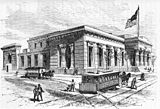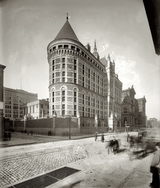- The Tombs
-
Coordinates: 40°42′59.8″N 74°00′05″W / 40.716611°N 74.00139°W
"The Tombs" is the colloquial name for the Manhattan Detention Complex, a jail in Lower Manhattan at 125 White Street, as well as the popular name of a series of preceding downtown jails, the first of which was built in 1838 in the Egyptian Revival style of architecture.[1]
The nickname has been used for several city-run jails in lower Manhattan in the former Five Points neighborhood, an area now known as the Civic Center. The original Tombs officially known as the Halls of Justice was built as a replacement for the colonial era Bridewell Prison located in what is today City Hall Park. Originally $250,000 was allocated in 1835 to build the Tombs, however various cost overuns occurred prior to completion of the project. The new structure incorporated material from the Bridewell ( built 1735 and demolished in 1838), mainly the granite, to save money.[2]
Contents
A mausoleum for the living
The first complex to have the nickname was built in 1838. The design, by John Haviland, was based on an engraving of an ancient Egyptian mausoleum. The building was 253 feet, 3 inches in length by 200 feet, 5 inches wide and it occupied a full block, surrounded by Centre, Franklin, Elm (today's Lafayette), and Leonard Streets. It initially accommodated about 300 prisoners.
The block on which the building stood had been created in by the filling-in of the Collect Pond, a freshwater pond that had once been the principal water source for colonial New York City. Industrialization and population density by the late 18th century resulted in the severe pollution of the Collect and it was condemned, drained and filled in by 1817. The landfill job was poorly done and in a span of less than ten years the ground began to subside.
The resulting swampy, foul-smelling conditions had already resulted in the quick transformation of the neighborhood into a slum known as Five Points by the time construction of the prison started in 1838. The enormous, heavy masonry of Haviland's building was built atop vertical "piles" of gigantic lashed hemlock tree trunks in a bid for stability, but the entire structure began to sink soon after it was opened. This damp foundation was primarily responsible for its bad reputation as being unsanitary during the decades to come.
As it also housed the city's courts, police, and detention facilities, The Tombs' more formal title was The New York Halls of Justice and House of Detention. Some regarded it as a notable example of Egyptian Revival architecture in the U.S., but opinion varied greatly concerning its actual merit. "What is this dismal fronted pile of bastard Egyptian, like an enchanter's palace in a melodrama?", asked Charles Dickens in his American Notes of 1842.
The prison was well known for its corruption and was the scene of numerous scandals and successful prison escapes during its early history. By 1850, many people were calling for its destruction.
By the early 20th century, reforms began to be made as the first prison school for younger inmates in an American adult correction facility was established by the Public Schools Association in 1900.
The original building was replaced in 1902 with a new one on the same site connected by a "Bridge of Sighs" to the Criminal Courts Building on the Franklin Street side. That building was replaced in 1941 by one across the street on the east side of Cetre Street with the entrance at 125White Street, officially named the Manhattan House of Detention, though still referred to popularly as "The Tombs".
Part of "the Tombs" was eventually closed in 1974 for security and health reasons. Soon thereafter, the structure was demolished and replaced with another building. The current jail comprises two buildings connected by a pedestrian bridge—a 381 bed tower that is the remaining part of the 1941 building at 100 Centre Street (completely remodeled in 1983), and a 500-bed tower north of it, opened in 1990.[1]
The current "Tombs" jail was named The Bernard B. Kerik Complex in December 2001 at the direction of Mayor Rudolph Giuliani; Kerik had been a well-regarded[3] corrections commissioner from 1998-2000 before becoming police commissioner. After Kerik's 2006 plea bargain admitting to two misdemeanor ethics violations dating from his tenure as a city employee, Mayor Michael Bloomberg ordered his name removed.[1]
In summary:
- Tombs I, 1838–1902, New York City Halls of Justice and House of Detention, building by John Haviland
- Tombs II, 1902–1941, Manhattan House of Detention
- Tombs III, 1941–1974, Manhattan House of Detention
- Tombs IV, 1974–present, Manhattan Detention Complex (Bernard B. Kerik Complex 2001-2006)
In popular culture
- The Tombs is the setting of the play Short Eyes by Miguel Piñero and its film adaptation.
- The Tombs is the setting for the endings of two works by Herman Melville: Pierre: or, The Ambiguities and Bartleby the Scrivener. Bartleby, apparently by willful starvation, dies on the grassy ground of an open yard in the prison, prompting his former employer to famously exclaim, "Ah Bartleby! Ah humanity!".
- William Burroughs refers to The Tombs in his semi-autobiographical book Junkie.
- The Tombs provides the setting of the 1937 pulp fiction story "Dictator of the Damned," in which The Spider stages a daring raid to help exonerate an innocent man.
- In the TV sitcom Barney Miller, the officers frequently mention that they will take an arrestee to The Tombs.
- Jim Carroll mentions in his song "People Who Died" that his friend Bobby committed suicide by hanging in the Tombs.
- TV dramas Law & Order and Law & Order: SVU regularly make references to The Tombs.
- In his autobiographical novel Memos from Purgatory, Harlan Ellison describes his brief incarceration in The Tombs following his arrest for possession of a firearm that he had used as a prop while lecturing.[4]
- In November 2000, 16 people associated with the Opie and Anthony radio show were arrested and held in The Tombs overnight during a promotion for "The Voyeur Bus", a mostly glass bus carting topless women through Manhattan with a police escort.[5]
- Eric Carter, the main character of Richard Price's novel Lush Life, is incarcerated in the Tombs.
- Towards the end of the movie American Gangster, Denzel Washington's character, Frank Lucas, is seen leaving prison after a 15-year sentence. This scene was filmed at the Tombs, although in real life prisoners are held there for relatively brief stays (arraignments, trials, etc.).
- The Tombs are referenced in the 2000 remake of Shaft, featuring Samuel L. Jackson.
- In the Wild Cards book series, Jay Ackroyd often uses his wild card power to teleport his enemies to the Tombs.
Further reading
- deFord, Miriam Allen (1962). Stone Walls: Prisons from Fetters to Furloughs. Philadelphia: Chilton. OCLC 378834.
- Johnson, James A. (2000). Forms of Constraint: A History of Prison Architecture. Urbana: University of Illinois Press. ISBN 9780252025570. OCLC 42434965.
- Sifakis, Carl (2003). The Encyclopedia of American Prisons. New York: Facts on File. ISBN 9780816045112. OCLC 49225908.
References
- ^ a b c "Disgraced and Penalized, Kerik Finds His Name Stripped Off Jail." Chan, Sewell, New York Times, July 3, 2006
- ^ Richard G. Carrott: The Egyptian revival: its sources, monuments, and meaning, 1808-1858,p.165; University of California Press (1978) ISBN 0520033248
- ^ New York Times Topics.http://topics.nytimes.com/top/reference/timestopics/people/k/bernard_b_kerik/index.html
- ^ Wilson, S. Michael (2001-07-22). "Paging Cordwainer Bird...." (Customer review of Memos from Purgatory). Amazon.com. http://www.amazon.com/review/R22QATRT3TOY2H/ref=cm_cr_rdp_perm/. Retrieved 2007-10-10.
- ^ RASHBAUM, WILLIAM (2000-02-12). "Escort of Voyeur Bus Suspended by Police". New York Times. http://select.nytimes.com/gst/abstract.html?res=F0081FFC34590C718CDDAB0994D8404482. Retrieved 2007-07-05.
- Gilfoyle, Timothy J. (2003). ""America's Greatest Criminal Barracks": The Tombs and the Experience of Criminal Justice in New York City, 1838-1897". Journal of Urban History 29 (5): 525–554. doi:10.1177/0096144203029005002. OCLC 88513081.
- Roth, Mitchel P. (2006). Prisons and Prison Systems: A Global Encyclopedia. Westport, Connecticut: Greenwood Press. ISBN 9780313328565. OCLC 60835344.
External links
- Berger, Meyer (1983) [1942]. "The Tombs". The Eight Million: Journal of a New York Correspondent (Columbia University Press Morningside ed.). New York: Columbia University Press. pp. 23–35.. ISBN 9780231057103. OCLC 9066227. http://www.uhb.fr/faulkner/ny/meyerberger1.htm. Retrieved 2007-10-10.
- New York Correction History Society timeline (includes photo)
- An early engraving by John Poppel.
- John DePol etching of a later building, 1942
- Painting of 1842 fire at The Tombs.
- "Irish in New York" site, Census of prisoners in 1860
- --News story.
Categories:- Buildings and structures completed in 1838
- Buildings and structures completed in 1902
- Buildings and structures completed in 1941
- Prisons in New York City
- Egyptian Revival architecture in the United States
- Five Points, Manhattan
Wikimedia Foundation. 2010.




